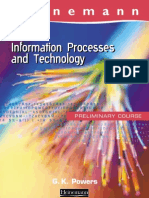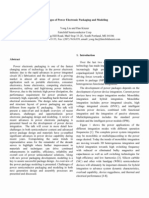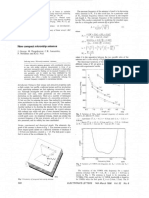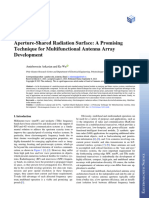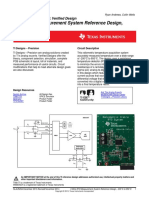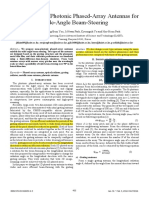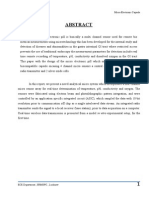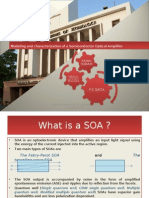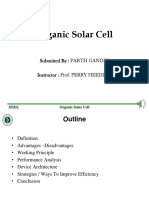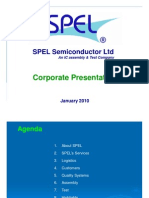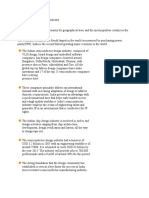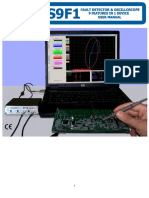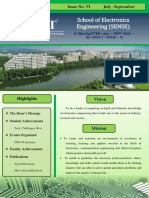Optical Computing-Abstract Ieee Format
Optical Computing-Abstract Ieee Format
Uploaded by
Jagadeesh SamalaCopyright:
Available Formats
Optical Computing-Abstract Ieee Format
Optical Computing-Abstract Ieee Format
Uploaded by
Jagadeesh SamalaOriginal Description:
Original Title
Copyright
Available Formats
Share this document
Did you find this document useful?
Is this content inappropriate?
Copyright:
Available Formats
Optical Computing-Abstract Ieee Format
Optical Computing-Abstract Ieee Format
Uploaded by
Jagadeesh SamalaCopyright:
Available Formats
Optical Computing
Samala Jagadheesh 12831D5509 Gurunanak Institute Of Technology. jagadeeshsamala@gmail.com
has been used in computing for a number of years but the main emphasis has been and continues to be to link portions of computers, for communications, or more intrinsically in devices that have some optical application or component (optical pattern recognition, etc). Optical digital computers are still some years away, however a number of devices that can ultimately lead to real optical computers have already been manufactured, including optical logic gates, optical switches, optical interconnections, and optical memory. The most likely near-term optical computer will really be a hybrid composed of traditional architectural design along with some portions that can perform some functional operations in optical mode.
ABSTRACTOptics
new kind of computer, which can perform all functional operations in optical mode. In recent years, a number of devices that can ultimately lead us to real optical computers have already been manufactured. These include optical logic gates, optical switches, optical interconnections and optical memory. Current trends in optical computing emphasize communications, for example the use of free space optical interconnects as a potential solution to remove Bottlenecks experienced in electronic architectures. Optical technology is one of the most promising, and may eventually lead to new computing applications as a consequence of faster processing speed, as well as better connectivity and higher bandwidth. .
KEYWORDS: optical, switch, interconections,
computers,logic gates.
I. INTRODUCTION With the growth of computing technology the need of high performance computers (HPC) has significantly increased. Optics has been used in computing for a number of years but the main emphasis has been and continues to be to link portions of computers, for communications, or more intrinsically in devices that have some optical application or component (optical pattern recognition etc.) Optical computing was a hot research area in 1980s.But the work tapered off due to materials limitations that prevented opt chips from getting small enough and cheap enough beyond laboratory curiosities. Now, optical computers are back with advances in self-assembled conducting organic polymers that promise super-tiny of all optical chips. Optical computing technology is, in general, developing in two directions. One approach is to build computers that have the same architecture as present day computers but using optics that is Electro optical hybrids. Another approach is to generate a completely
Fig. Optical Interconnection Of Circuit
Boards Using Vcsel And Photodiode
II.NEED FOR OPTICALCOMPUTING
The pressing need for optical technology stems from the fact that todays computers are limited by the time response of electronic circuits. A solid transmission medium limits both the speed and volume of signals, as well as building up heat that damages components. One of the theoretical limits on how fast a computer can function is given by Einsteins principle that signal cannot propagate faster than speed of light. So to make computers faster, their components must be smaller and there by decrease the distance between them. This has resulted in the development of very large scale integration (VLSI) technology, with smaller device dimensions and greater complexity. The optical computer comes as a solution of miniaturization problem. Optical data processing can perform several operations in parallel much faster and easier than electrons. This parallelism helps in staggering computational power. For example a calculation that takes a conventional electronic computer more than 11 years to complete could be performed by an optical computer in a single hour. Any way we can realize that in an optical computer, electrons are replaced by photons, the subatomic bits of electromagnetic radiation that make up light.
[5] S. J. van Enk, J. McKeever, H. J. Kimble, and J. Ye, "Cooling of a single atom in an optical trap inside a resonator," Phys. Rev. A 64, 013407 (2001).
.
III. REFERENCES
[1] See for example: Chemical and Engineering (ews, "Photonic Crystals. Assembled on Chip", 79(47), 31 (2001). [2] P. Boffi, D. Piccinin, M.C. Ubaldi, (Eds.), Infrared Holography for Optical Communications echniques,MaterialsandDevices,SpringerTopics in Applied Physics: Vol 86, July 2002. [3] Alain Goulet, Makoto Naruse, and Masatoshi Ishikawa, "Simple integration technique to realize parallel optical interconnects: implementation of a pluggable two-dimensional optical data link", Applied Optics 41, 5538 (2002) [4] Tushar Mahapatra, Sanjay Mishra, Oracle Parallel Processing, O'Reilly & Associates, Inc., Sebastopol, California, USA, 2000.
You might also like
- Pfc-Control-Ic-Fa1a60n 58 PowerDocument7 pagesPfc-Control-Ic-Fa1a60n 58 PowerTDFRIOGRANDE100% (1)
- Cmos ElectronicDocument356 pagesCmos ElectronicJustin WilliamsNo ratings yet
- Elsherbeni - FEKO - CJ Reddy PDFDocument245 pagesElsherbeni - FEKO - CJ Reddy PDFVidyadhar Melkeri0% (1)
- IPTPrelimDocument321 pagesIPTPrelimspecialityNo ratings yet
- Optical ComputersDocument46 pagesOptical ComputersManjunath MgNo ratings yet
- Optical ComputersDocument4 pagesOptical ComputersAnirudha M V0% (1)
- Final PPT Optical ComputersDocument24 pagesFinal PPT Optical Computersvidwathgowda75% (8)
- Challenges of Power Electronic Packaging and ModelingDocument9 pagesChallenges of Power Electronic Packaging and ModelinglimityyNo ratings yet
- New Compact Microstrip AntennaDocument2 pagesNew Compact Microstrip AntennaRajbala SolankiNo ratings yet
- Microelectronics Reliability: Yong LiuDocument8 pagesMicroelectronics Reliability: Yong Liu李云龙No ratings yet
- Holographic Beamforming WP v.6C FINALDocument8 pagesHolographic Beamforming WP v.6C FINALsameerNo ratings yet
- Stats eWLB OverviewFlyer PDFDocument4 pagesStats eWLB OverviewFlyer PDFChris TanNo ratings yet
- Aperture-Shared Radiation Surface A Promising Technique For Multifunctional Antenna Array DevelopmentDocument20 pagesAperture-Shared Radiation Surface A Promising Technique For Multifunctional Antenna Array DevelopmentpikothemanNo ratings yet
- RF Based Home Appliances Control SystemDocument45 pagesRF Based Home Appliances Control SystemJames OnoniwuNo ratings yet
- Triangular Patch Antenna 1Document3 pagesTriangular Patch Antenna 1Isha JainNo ratings yet
- 32 Antenna Arrays PDFDocument15 pages32 Antenna Arrays PDFshynusvNo ratings yet
- Could Copper Pillar Change The OSAT EcosystemDocument4 pagesCould Copper Pillar Change The OSAT EcosystemrhaudiogeekNo ratings yet
- Mca Digital Smell Technology ReportDocument22 pagesMca Digital Smell Technology Reportprajwal mishraNo ratings yet
- FIR Filter Project ReportDocument12 pagesFIR Filter Project ReportDebayan ChatterjeeNo ratings yet
- Gate Drive Design For Paralleled SiC MOSFETs in High Power Voltage Source ConvertersDocument104 pagesGate Drive Design For Paralleled SiC MOSFETs in High Power Voltage Source Convertersahmed bakareNo ratings yet
- Software Defined AIS Receiver Implementation Based On RTL-SDR and GNU RadioDocument5 pagesSoftware Defined AIS Receiver Implementation Based On RTL-SDR and GNU RadioDeepa BharathiNo ratings yet
- 2017-Ultra-Thin Metasurface Microwave Flat Lens For Broadband Applications-AIPDocument6 pages2017-Ultra-Thin Metasurface Microwave Flat Lens For Broadband Applications-AIPYumna SiddiqueNo ratings yet
- ReportDocument74 pagesReportAnshuman GiriNo ratings yet
- RFID Based Attendance SystemDocument3 pagesRFID Based Attendance SystemKulbir GodaraNo ratings yet
- Focusing On Bandwidth: Achromatic Metalens Limits: F P F MDocument8 pagesFocusing On Bandwidth: Achromatic Metalens Limits: F P F MAmit Kumar BaghelNo ratings yet
- 3-Wire RTD Measurement System Reference Design, - 200°C To 850°CDocument39 pages3-Wire RTD Measurement System Reference Design, - 200°C To 850°CMilan ĐorđevicNo ratings yet
- Lecture Notes Engineering Society 3.4Document75 pagesLecture Notes Engineering Society 3.4Yousab CreatorNo ratings yet
- Design of Nano-Photonic Phased-Array AntennasDocument4 pagesDesign of Nano-Photonic Phased-Array AntennasmubujeeNo ratings yet
- ISSCC2009 ProgDocument107 pagesISSCC2009 Prognxp HeNo ratings yet
- Micro Electronic PillDocument29 pagesMicro Electronic PillRohan SharmaNo ratings yet
- EE2003 Semiconductor Fundamentals - OBTLDocument6 pagesEE2003 Semiconductor Fundamentals - OBTLAaron TanNo ratings yet
- EMC Aspects of High Speed Digital DesignDocument30 pagesEMC Aspects of High Speed Digital DesignMuhammad ShihabNo ratings yet
- Design and Simulation of Bulk Acoustic Wave MEMS ResonatorDocument7 pagesDesign and Simulation of Bulk Acoustic Wave MEMS ResonatorIJeeteNo ratings yet
- PV - Overview of Real-Time Lifetime Prediction and Extension For SiC Power ConvertersDocument29 pagesPV - Overview of Real-Time Lifetime Prediction and Extension For SiC Power ConvertersCB MildredNo ratings yet
- 3.3 Led Structures 3.3.1 Surface Emitter LedsDocument3 pages3.3 Led Structures 3.3.1 Surface Emitter Ledssansiy jeyNo ratings yet
- Semiconductor Optical AmplifierDocument10 pagesSemiconductor Optical Amplifierapi-26832469No ratings yet
- Advances On Digital Television and Wireless Multimedia Communications PDFDocument530 pagesAdvances On Digital Television and Wireless Multimedia Communications PDFxmisterioNo ratings yet
- 19h45a0423 Seminar Report NewDocument46 pages19h45a0423 Seminar Report NewtejaswiNo ratings yet
- Part - B Unit - 5 Multimedia Information Networks Introduction, Lans, Ethernet, Token Ring, Bridges, Fddi High-Speed Lans, Lan Protocol. 7 HoursDocument33 pagesPart - B Unit - 5 Multimedia Information Networks Introduction, Lans, Ethernet, Token Ring, Bridges, Fddi High-Speed Lans, Lan Protocol. 7 HoursDeepa JerinNo ratings yet
- Hardware Program Project Manager in San Francisco Bay CA Resume Evan ChangDocument2 pagesHardware Program Project Manager in San Francisco Bay CA Resume Evan ChangEvanChangNo ratings yet
- Ai in ElectronicsDocument24 pagesAi in ElectronicsAniket Kumar SinghNo ratings yet
- MM Apr2023Document104 pagesMM Apr2023hemanthgedela100% (1)
- A Systematic Review On MEMS GyroscopeDocument6 pagesA Systematic Review On MEMS GyroscopeArjun KapoorNo ratings yet
- Organic Solar Cell PDFDocument9 pagesOrganic Solar Cell PDFFeiTenNo ratings yet
- Materials For MEMS ManufacturingDocument7 pagesMaterials For MEMS ManufacturingGajanan BirajdarNo ratings yet
- MSDL Organic Solar Cell Parth Gandhi Rev2Document22 pagesMSDL Organic Solar Cell Parth Gandhi Rev2parth155No ratings yet
- Amit Singh Smart Antenna DesignDocument24 pagesAmit Singh Smart Antenna DesignYasha Ir0% (1)
- 3D Ics With Tsvs-Design Challenges and Requirements: Introductio NDocument11 pages3D Ics With Tsvs-Design Challenges and Requirements: Introductio NphanindrabodduNo ratings yet
- Unit 5IC FebricationDocument29 pagesUnit 5IC Febricationsvnet vizagNo ratings yet
- Report On Catch Me If You Can GameDocument4 pagesReport On Catch Me If You Can GameNeelima Chowdary BattulaNo ratings yet
- M. Satyasiva Ramesh: Personal ProfileDocument2 pagesM. Satyasiva Ramesh: Personal ProfileRamesh MattaparthiNo ratings yet
- MATLAB Excercise For Image Processing IIDocument6 pagesMATLAB Excercise For Image Processing IIAhmed MiddleEastNo ratings yet
- Amoled NewDocument26 pagesAmoled NewLate ComerNo ratings yet
- PDF LokDocument43 pagesPDF LokSaroSureshNo ratings yet
- Long Term VisionDocument102 pagesLong Term VisionGabriel DonovanNo ratings yet
- A Techno-Economic Framework For Satellite Networks Applied To Low Earth Orbit Constellations Assessing Starlink OneWeb and KuiperDocument15 pagesA Techno-Economic Framework For Satellite Networks Applied To Low Earth Orbit Constellations Assessing Starlink OneWeb and KuiperÃśhîśh ŠíñghNo ratings yet
- The Indian Semiconductor IndustryDocument6 pagesThe Indian Semiconductor IndustrySunil PillaiNo ratings yet
- VLSI System Design Using Verilog - Step by Step Designing Procedure For CADENCE Incisive Enterprise SimulatorDocument150 pagesVLSI System Design Using Verilog - Step by Step Designing Procedure For CADENCE Incisive Enterprise Simulatorkolaverididhanush1No ratings yet
- Chapter 9: Communications Systems: Learning ObjectivesDocument19 pagesChapter 9: Communications Systems: Learning ObjectiveskentNo ratings yet
- Emerging Technologies in Information and Communications TechnologyFrom EverandEmerging Technologies in Information and Communications TechnologyNo ratings yet
- New Sensors and Processing ChainFrom EverandNew Sensors and Processing ChainJean-Hugh ThomasNo ratings yet
- CS10K Curated Content: CSP Number 2: Abstraction: A Continuing ConversationDocument1 pageCS10K Curated Content: CSP Number 2: Abstraction: A Continuing ConversationLauren AmosNo ratings yet
- Unit 1 Es&iotDocument15 pagesUnit 1 Es&iotChaitanya VarmaNo ratings yet
- Thesis On LFSRDocument104 pagesThesis On LFSRKaran RoyNo ratings yet
- MCS-012 Block 1Document103 pagesMCS-012 Block 1Abhishek VeerkarNo ratings yet
- Fados9f1 User ManualDocument39 pagesFados9f1 User Manualrockensysa0% (1)
- CMOS Fabrication Process (Detailed) PDFDocument48 pagesCMOS Fabrication Process (Detailed) PDFnafiz hridoyNo ratings yet
- HCF 4511 BEDocument16 pagesHCF 4511 BEy2k_yah7758No ratings yet
- Electronics LifeDocument23 pagesElectronics LifeBlind LuvNo ratings yet
- ELEC-E3520 Digital Microelectronics I: Marko KosunenDocument38 pagesELEC-E3520 Digital Microelectronics I: Marko KosunenMuhammad Royyan ZahirNo ratings yet
- Microprocessors and Microcontrollers: Dr. S. ElangovanDocument17 pagesMicroprocessors and Microcontrollers: Dr. S. ElangovanDr.S .ElangovanNo ratings yet
- Seminar FinalDocument29 pagesSeminar FinalAmulya ReddyNo ratings yet
- Image Processing Using FPGADocument12 pagesImage Processing Using FPGAMehanathan Maggie MikeyNo ratings yet
- 20171019 Turing Tumble Book - Standard Edition SmallDocument120 pages20171019 Turing Tumble Book - Standard Edition Smallnana.ibrahimNo ratings yet
- Introduction To Computing Com 101Document48 pagesIntroduction To Computing Com 101EBUBE100% (1)
- Evolution of Computers & Computer System: Grade 12 Competency Level 2.1 Anuradha DissanayakeDocument14 pagesEvolution of Computers & Computer System: Grade 12 Competency Level 2.1 Anuradha DissanayakeVijani RajapathiranaNo ratings yet
- Deca Tec FO WLPDocument14 pagesDeca Tec FO WLPAhSangCheeSangNo ratings yet
- EPP With ENTREP MODULESDocument64 pagesEPP With ENTREP MODULESmoralesperpetua645No ratings yet
- Q3 2021 SENSE E NewsletterDocument17 pagesQ3 2021 SENSE E NewsletterVIJAY KUMARNo ratings yet
- Computer Application in Business B.Com Part 1 Book FullDocument192 pagesComputer Application in Business B.Com Part 1 Book FullAbubakar SidiqueNo ratings yet
- PSG Tech ProfileDocument48 pagesPSG Tech ProfileReddy BabuNo ratings yet
- Introduction To Mems: © Prof. (DR.) Chetan B. BhattDocument19 pagesIntroduction To Mems: © Prof. (DR.) Chetan B. Bhattchetan_bhattNo ratings yet
- 1st Periodical-2022-23 ICTDocument5 pages1st Periodical-2022-23 ICTmargie faustinoNo ratings yet
- Transdutor - MPX2300DT1Document7 pagesTransdutor - MPX2300DT1ドスサントスジョアンビキトルNo ratings yet
- ISI Engineering Electrical & Electronic JournalsDocument12 pagesISI Engineering Electrical & Electronic JournalsHo Manh LinhNo ratings yet
- Chapter 10Document44 pagesChapter 10Sridhar ReddyNo ratings yet
- ABB Review NR 2 2013Document80 pagesABB Review NR 2 2013sorin1gunnerNo ratings yet
- 9th Class Computer Science Important QuestionsDocument46 pages9th Class Computer Science Important Questionszahida parveen60% (5)



